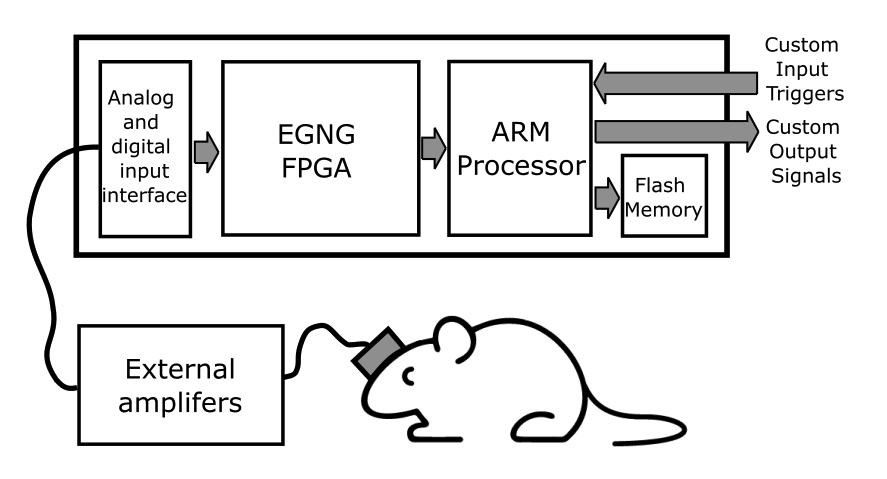




BY RESEARCHERS, FOR RESEARCHERS
Spike Sorting
PopNeuron’s GEMsort algorithm revolutionizes neural spike sorting by enabling real-time processing of complex neural data from multi-channel recordings. This innovative approach uses graph clustering to accurately identify and sort neural spikes as they occur, facilitating immediate analysis without significant computational demands. Designed for compatibility with existing recording systems, PopNeuron’s technology offers a practical solution for researchers to enhance the precision and efficiency of brain activity studies.
Unified Precision in Neuroscience
- Real-Time Processing: Instantly analyzes and sorts neural spikes from hundreds of recording channels.
- Innovative Graph Clustering: Employs a novel mathematical approach for accurate spike identification.
- Plug-and-Play Compatibility: Seamlessly integrates with existing recording setups, avoiding costly upgrades.
- Adaptable to Changes: Automatically adjusts to environmental variations like probe drifts, ensuring consistent data accuracy.

What We’re Offering
What Makes Us Different
PopNeuron’s advanced technology overcomes traditional neuroscience tool limitations, offering innovative, automated, high-precision targeting with enhanced accuracy, reproducibility, and global consistency through a collaborative, cloud-based platform for diverse research needs.

- Overcomes Traditional Limitations
- Innovative Integration of Technology
- Enhanced Accuracy and Reproducibility
- Automated Calibration and Consistency
- Collaborative and Versatile Platform

High channel live spike sorting with GemSORT (Graph nEtwork Multichannel neural spike sorting)
The brain processes information by sending small electric events called action potentials or spikes between neurons. Thus, one obvious way to study how the brain works involves recording and analyzing these spikes over time, which is most commonly done with a technique called extracellular in-vivo recordings. While such recordings have been performed for decades, there have been several break-through innovations during the last few years which have greatly enhanced the power and the appeal of this technique. One of these is the advent of multi-channel and high-channel recording equipment that enables an investigator to record neural activity through dozens or even hundreds of channels and thus acquire a much more accurate and complete picture of how populations of neurons process neural information.
A major challenge which is growing with the increase in the number of recording channels is the ability to process these large amounts of incoming data, particularly in real-time. Spike sorting, a common first step in analyzing neural activity measured from a multichannel probe, is one such bottleneck. Due to the close proximity of neurons to each other, whenever an electrode is placed into the brain, it will often pick up electrical signals from more than one neuron, resulting in the spike waveforms of several neurons being electrically combined into so-called “multi-unit” activity. Spike sorting algorithms are then used to separate this multi-unit activity into several sets of “single-unit” activity, each of which represents the action potential firing pattern of a single neuron. Although a number of sophisticated spike sorting algorithms have been developed, many of these are relatively slow and designed to sort data post-hoc after the conclusion of a recording session. This is especially true for recordings consisting of many or even hundreds of channels.
Additionally, due to the mathematical approaches many algorithms were based upon, they have to examine the entire set of neural spikes only once it is completely recorded in order to come up with the best sorting accuracy, and thus can only provide sorting outcomes at the very end of the analysis. Some algorithms do allow for near-live sorting. However, due to computational demands, the investigator is asked to select a very small subset of the incoming data stream such as one channel out of many for sorting. Therefore, novel mathematical approaches to sort individual spikes with a short processing time are needed.
The GEMsort algorithm is a real-time neural spike sorting algorithm using a novel mathematical approach of graph clustering. Using this new mathematical approach, the algorithm can learn the dissimilarities between neural spikes fired from different neurons as the neural spikes are being measured in real-time. With this unique graph clustering approach, a neural spike can be analyzed and sorted as soon as the spike is measured with very minimal processing time (< 1 ms). Additionally, the GEMsort algorithm is designed to allow parallel computations. When combined with the latest state-of-the-art digital electronics, the algorithm can provide real-time neural spike sorting even when neural spikes are simultaneously measured from hundreds of recording channels. This unique real-time sorting capability can open the door to new approaches to studying brain circuitry, including real-time neural dynamic decoding and closed-loop neural feedback stimulations based on the real-time analyzed neural dynamics.
Another unique capability of the GEMsort algorithm is its ability to self-adapt to changes in the electrophysiology environment, such as probe drifts during long recording sessions which cause profile changes in the electrical signatures of neural spikes. Due to the learning on-the-fly adaptability of the algorithm, the GEMsort algorithm can “follow” changes in the neural spikes for continuous and correct sorting. This self-adapting sorting feature allows extremely long recording sessions to track neural activities without wasting any “down times” for neuroscience studies.
PopNeuron is currently developing an electronic add-on to allow investigators using their existing recording systems and additionally have the capability to sort neural spikes in real-time, even with hundreds of simultaneously recorded channels streaming a large amount of data. This electronic add-on device can simply be plugged into the recording computer, without the needs of investing on expensive GPU or GPUs. The sorting will be entirely processed within the electronic add-on, and the computational resources of the main computer will be preserved for data analysis or other experimentally required computations.
Interested in being a beta tester? Contact us!
Documentation and Software
By using PopNeuron software, you agree to our End-User License Agreement, available here.
Currently In-Development
Related Publication:
Computationally inexpensive enhanced growing neural gas algorithm for real-time adaptive neural spike clustering. Zeinab Mohammadi, John M Kincaid, Sio Hang Pun, Achim Klug, Chao Liu, Tim C Lei J Neural Eng 2019 Jul 30;16(5):056007. doi: 10.1088/1741-2552/ab208c.
Related Patent:
Process and hardware implementation of adaptive real-time neural spike sorting. Tim Chifong Lei, Zeinab Mohammadi, Achim Klug, Chao Liu U.S. Patent 11,622,727
Terms and Conditions
Please read these Terms and Conditions (“Terms”, “Terms and Conditions”) carefully before using the website and purchasing any products from PopNeuron LLC (“us”, “we”, or “our”).
- Agreement to Terms
By accessing or using our website and purchasing any products from us, you agree to be bound by these Terms. If you disagree with any part of the terms, then you may not access the website or initiate a purchase.
- Products
- Our products are intended for use in accordance with applicable regulations and guidelines. It is your responsibility to ensure that the products purchased are suitable for your intended use.
- We strive to accurately represent our products, including descriptions, images, and specifications, but we do not guarantee that such information is complete, current, or error-free.
- Orders and Payment
- By placing an order through our website, you warrant that you are legally capable of entering into binding contracts and that all information you provide is accurate and complete.
- Prices for our products are subject to change without notice. We reserve the right to modify or discontinue any product at any time without prior notice.
- Payment must be made in full at the time of purchase. We accept various forms of payment as indicated on our website.
- Shipping and Delivery
- We aim to ship orders promptly; however, delivery times may vary depending on factors beyond our control. We are not liable for any delays in delivery.
- Risk of loss and title for products purchased from us pass to you upon delivery of the items to the carrier.
- Returns and Refunds
- Please refer to our Warranty and Return Policy [link] for information on returns and refunds.
- Warranty
- Our products may be subject to warranties provided by the manufacturer. Please refer to the specific product documentation for warranty details, as well as our Warranty and Return Policy [link].
- Limitation of Liability
- In no event shall PopNeuron LLC, nor its directors, employees, partners, agents, suppliers, or affiliates, be liable for any indirect, incidental, special, consequential, or punitive damages, including without limitation, loss of profits, data, use, goodwill, or other intangible losses, resulting from (i) your access to or use of or inability to access or use the website; (ii) any conduct or content of any third party on the website; (iii) any content obtained from the website; and (iv) unauthorized access, use, or alteration of your transmissions or content, whether based on warranty, contract, tort (including negligence), or any other legal theory, whether or not we have been informed of the possibility of such damage, and even if a remedy set forth herein is found to have failed of its essential purpose.
- Governing Law
- These Terms shall be governed and construed in accordance with the laws of Colorado, without regard to its conflict of law provisions.
- Changes to Terms
- We reserve the right, at our sole discretion, to modify or replace these Terms at any time. If a revision is material, we will try to provide at least 30 days’ notice prior to any new terms taking effect. What constitutes a material change will be determined at our sole discretion.
- Contact Us
- If you have any questions about these Terms, please contact us at frontdesk@popneuron.com.
By using our website and purchasing our products, you acknowledge that you have read, understood, and agree to be bound by these Terms and Conditions.

